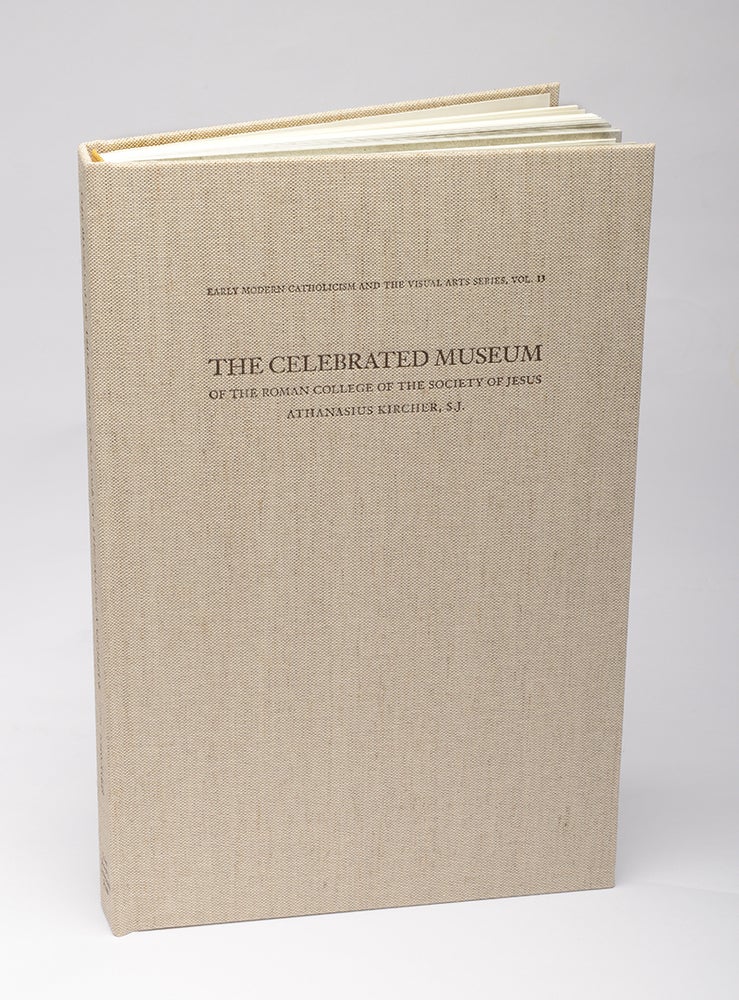
The Celebrated Museum of the Roman College of the Society of Jesus; A facsimile of the 1678 Amsterdam edition of Giorgio de Sepi's description of Athanasius Kircher's Museum
Price: $120.00
Place Published: Philadelphia
Publisher: Saint Joseph's University Press
Date Published: December 2015
ISBN: 9780916101879
Book ID: 80
Description:
With a translation of the Latin text by Anastasi Callinicos and Daniel Höhr, annotated by Jane Stevenson.
Edited, with an afterword, by Peter Davidson
Early Modern Catholicism and the Visual Arts Series, Vol. 13
ISBN 978-0-91610-87-9
172 pages / 10 x 15 in. / the facsimile includes 28 illustrations and 7 folio-size foldouts (28 ¾" x 18")
Athanasius Kircher's catalogue of the prodigious early museum (a Wunderkammer or cabinet of curiosities) which he assembled and arranged at the Roman College of the Society of Jesus was completed by his assistant Giorgio de Sepi for publication in 1678. This publication, with many expertly-engraved illustrations, is one of the most sumptuous and most curious examples of high baroque book production. It has memorable images of exotic birds and animals, of one of the first magic-lanterns or projected images, its text hints at the presence of machines which are little short of computers, it also illustrates numerous wonderful machines, be those clockwork automata, chiming and ambulant clocks, or multiplying and distorting mirrors. It is perhaps most famous for the exceptionally lavish fold-out plates of Roman obelisks which it contains, each page dedicated to one of the obelisks re-discovered in baroque Rome or new obelisks with pseudo-hierolgyphics by Kircher, devised according to his own scheme of interpretation of hieroglyphics as pictograms or, in baroque practice, emblems or impresa.
A full facsimile, including foldout plates, is offered here, together with the first English translation of a notoriously problematic Latin text. There is also a commentary to the translation, identifying objects, sources and facts while also explaining something of the status which the museum and its description share, as epitomes of the scarcely-credible range of activities and disciplines in which Kircher involved himself. The commentary also identifies passages which refer to others of Kircher's numerous and prodigious works. The edition also contains an afterword, reflecting on the current state of scholarship on Kircher, his museum, and his world. At last a text which has often been mentioned in studies of baroque Rome, of museums in early-modern Italy, of intellectual networks in 17th-century Europe, is available to the English-speaking reader in a lavish edition which preserves and enhances the splendor of the original production.
Table of Contents
Facsimile Edition
English Translation
Afterword
Notes for a Bibliography
Daniel Höhr teaches languages and music in his native Rhineland.
Anastasi Kallinikos is Head of Classics and Arundell Librarian at Stonyhurst College, Clitheror, Lancashire.
Jane Stevenson has taught at the Universities of Aberdeen, Warwick and Sheffield.
Peter Davidson is Senior Research Fellow of Campion Hall, University of Oxford.
Athansius Kircher's Celebrated Museum, a prodigious baroque book recording the vast cabinet of curiosities of the Society of Jesus at the Roman College, is here given in facsimile for the first time with full English translation and commentary.
CRITICAL ACCLAIM
"This superbly produced edition, with many expertly-engraved illustrations is one of the most sumptuous and most curious examples of high baroque book production. It has memorable images of exotic bird and animals, of one of the first magic-lanterns or projected images, its text hints at the presence of machines which are little short of computers, it also illustrates numerous wonderful machines, be those clockwork automata, chiming and ambulant clocks, or multiplying and distorting mirrors. It is perhaps most famous for the exceptionally lavish fold-out plates of Roman obelisks which it contains, each page dedicated to one of the obelisks re-discovered in baroque Rome or new obelisks with pseudo-hieroglyphics by Kircher, devised according to his own scheme or interpretation or hieroglyphics as pictograms or, in baroque practice, emblems or impresa. . . . This impressively reproduced 10" x 15" facsimile includes 28 illustrations and 7 folio-size foldouts (28 ¾" x 18"). The Celebrated Museum of the Roman College of the Society of Jesus is an ideal and very highly recommended addition to seminary, college, and university library Renaissance History and Jesuit History reference collections and supplemental reading lists."
Paul T. Vogel, Midwest Book Review
"[I]t is a great pleasure to have an accessible bilingual edition that also gives readers a feel for the original, including the large foldout illustrations of the obelisks 'decoded' in Kircher's many works of Egyptology, the Nestorian stele feature in his 1667 book on China as testimony to the antiquity of Christianity in Asia, and many images of foreign animals, idols, and machines including iconic curiosities such as Kircher's Delphic Oracle and magic lantern. This is a book one wants to linger over, in order to absorb the totality of its effect, indeed, take a tour with the mind's eye."
Paula Findlen (Stanford University), Journal of Jesuit Studies
"It is [the] Jesuit pursuit of earthly and divine connectedness via learning that the present volume from Saint Joseph's University Press honors so well. With this book, the publisher has returned us to one of the Collegio's most important publications. Handsomely bound in classic thick-weave cloth, this folio-size volume contains a facsimile of the Musæum Celeberrimum's printing of 1678 and an English translation. . . . Perhaps the most impressive feature of the original volume, and one to which Saint Joseph's has remained true, was its inclusion of seven foldout prints. . . . [T]his beautiful book is a boon to the study of collecting and the cult of the marvelous."
Arthur J. Di Furia (Savannah College of Art and Design), Renaissance Quarterly



